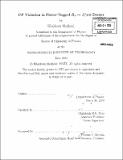| dc.contributor.advisor | Christoph M.E. Paus. | en_US |
| dc.contributor.author | Makhoul, Khaldoun | en_US |
| dc.contributor.other | Massachusetts Institute of Technology. Dept. of Physics. | en_US |
| dc.date.accessioned | 2010-03-25T15:18:31Z | |
| dc.date.available | 2010-03-25T15:18:31Z | |
| dc.date.copyright | 2009 | en_US |
| dc.date.issued | 2009 | en_US |
| dc.identifier.uri | http://hdl.handle.net/1721.1/53233 | |
| dc.description | Thesis (Ph. D.)--Massachusetts Institute of Technology, Dept. of Physics, 2009. | en_US |
| dc.description | In title on title page, [psi][phi] appears as lower case Greek letter italic and double underscored "s" appears as subscript. Cataloged from PDF version of thesis. | en_US |
| dc.description | Includes bibliographical references (p. 193-200). | en_US |
| dc.description.abstract | In this dissertation, we present the results of a time-dependent angular analysis of Bs -+ J/,0 decays performed with the use of initial-state flavor tagging. CP violation is observed in this mode through the interference of decay without net mixing and decay with net mixing, that is, Bs -- J/0 and Bs -+ B, -+ J/q0. The time-dependent angular analysis is used to extract the decay widths of the heavy and light B, eigenstates and the difference between these decay widths AF, - FL - FH. Initial-state flavor tagging is used to determine the matter-antimatter content of the B. mesons at production time. We combine flavor tagging with the angular analysis, which statistically determines the contributions of the CP-even and CP- odd components at decay time, to measure the CP-violating phase 0,. The phase 3, is expressed in terms of elements of the Cabibbo-Kobayashi-Maskawa matrix as s - arg (-VtsV4/VcsV*b), and is predicted by the Standard Model to be close to zero, O3SM = 0.02. In the measurement of AF,, we use a dataset corresponding to 1.7 fb- of luminosity, collected at the CDF experiment from proton-antiproton collisions at a center of mass energy f = 1.96 TeV. In the measurement of Ps, we use a dataset corresponding to 1.3 fb-1 of collected luminosity. We measure AF, = (0.071+0.064 ± 0.007) ps-1 using the time-dependent angular analysis. Combining the angular analysis with flavor-tagging, we find that assuming the Standard Model predictions of p/ and AF,, the probability of a deviation as large as the level of the observed data is 33%. We obtain a suite of associated results which are discussed in detail in this dissertation alongside the main results. | en_US |
| dc.description.statementofresponsibility | by Khaldoun Makhoul. | en_US |
| dc.format.extent | 200 p. | en_US |
| dc.language.iso | eng | en_US |
| dc.publisher | Massachusetts Institute of Technology | en_US |
| dc.rights | M.I.T. theses are protected by
copyright. They may be viewed from this source for any purpose, but
reproduction or distribution in any format is prohibited without written
permission. See provided URL for inquiries about permission. | en_US |
| dc.rights.uri | http://dspace.mit.edu/handle/1721.1/7582 | en_US |
| dc.subject | Physics. | en_US |
| dc.title | CP violation in flavor-tagged Bs̳ --> J/[psi][phi] decays | en_US |
| dc.type | Thesis | en_US |
| dc.description.degree | Ph.D. | en_US |
| dc.contributor.department | Massachusetts Institute of Technology. Department of Physics | |
| dc.identifier.oclc | 535518559 | en_US |
